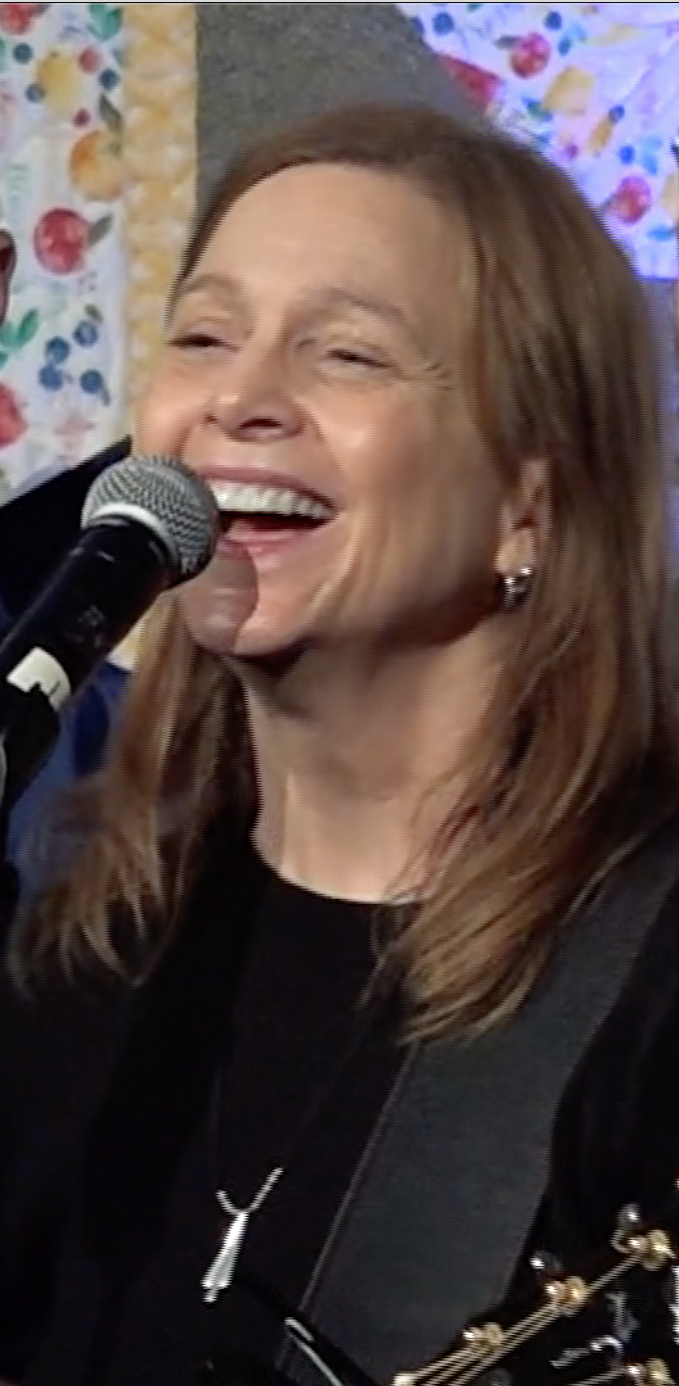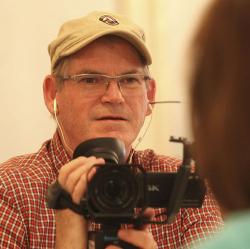[Editor’s Note: Since 1994, the annual Soup Bowl Benefit for the Hoosier Hills Food Bank has raised more than $1.5 million. In this oral history, Duane Busick shows in words and video the history, behind-the-scenes action, and impact the benefit has had on fighting hunger. Duane’s video follows the article. Ticket information and more details about the 27th Soup Bowl Benefit can also be found at the end of the article, or at the Hoosier Hill website.]
Bloomington author Scott Russell Sanders has been volunteering for more than ten years at the Soup Bowl Benefit for the Hoosier Hills Food Bank. Before putting on his apron to begin serving soup at the 25th annual benefit at the Monroe Convention Center in 2019, Sanders said this about the event:
“I think the Soup Bowl Benefit epitomizes what any community, not just Bloomington, but what any community can do to address needs within their community. So many people have donated their talents [and] their food — musicians, potters, chefs, restaurant owners, business donors. … It epitomizes what a community can do when they pool their resources and act out of generous motives to relieve suffering.”
Another soup server preparing for the event was Carrie Newcomer. Newcomer and her husband, Robert Meitus, are responsible for starting this fundraiser in Bloomington. “I’m a musician and we were doing a performance in the [Upper Peninsula] of Michigan,” Newcomer said. “The presenter of the show was an art teacher in a local high school, and he had done a version of this. He had local artists make bowls and local painters paint them. But the idea was such a great idea, and he said, ‘Run with it.’ And so we did our own version of that.”
“When Carrie and I came back from Michigan,” Meitus added, “… we got a bunch of friends together — Suzanne Halvorson, Jim Halvorson, and a bunch of friends — and twenty-five years later I think we’ve raised one and a half million dollars for Hoosier Hills Food Bank.”
That $1.5 million averages $60,000 per year for 25 years to help combat hunger in the community. The first Soup Bowl Benefit was held in 1994 and raised nearly $4,000; the 2020 Soup Bowl raised more than $150,000.
“Who knew we would do this for 25 years?” Newcomer said. “It was not something we had planned.”
Jenny Bass and Licia Weber volunteered as soup servers. Bass explained how fundraising for the event has evolved. “There’s now a really solid fundraising committee, which was not there at the beginning,” she said. “It was pretty much dependent on ticket sales, and now we’re the biggest fundraiser for the Hoosier Hills Food Bank. The fundraising team has been really great about getting sponsors, and the event is so popular right now it’s really not hard to get sponsors because people want to be a part of it.”
“What’s been critical,” Weber said, “is that we’ve had so much support from the community, the restaurants, potters, and sponsors. It’s sort of become its own magical thing.”
“It’s really such a feel-good event,” Newcomer said. “It just feels like such a celebration of the community, a celebration of the arts in the community, a celebration of local businesses — and the generosity of the local businesses — of the food bank itself and all the work that they’re doing. It really feels like such a deep-down community event now. It’s really wonderful.”
The core committee for the Soup Bowl Benefit has stayed the same through all these years, and usually has only one meeting a year.
“We got our emcees, our soup deliverers, our potters, and our decorators,” Bass said, “and everybody knows what their job is.”
Textile artist Suzanne Halvorson is co-coordinator of decorations. For her and her potter husband, Jim Halvorson, the Soup Bowl will always remind them of Barb Bihler, the person who first sought out and organized potters for the fundraiser. About a year after the first Soup Bowl, Bihler formed the Local Clay Potters’ Guild, which has made bowls for the benefit ever since.
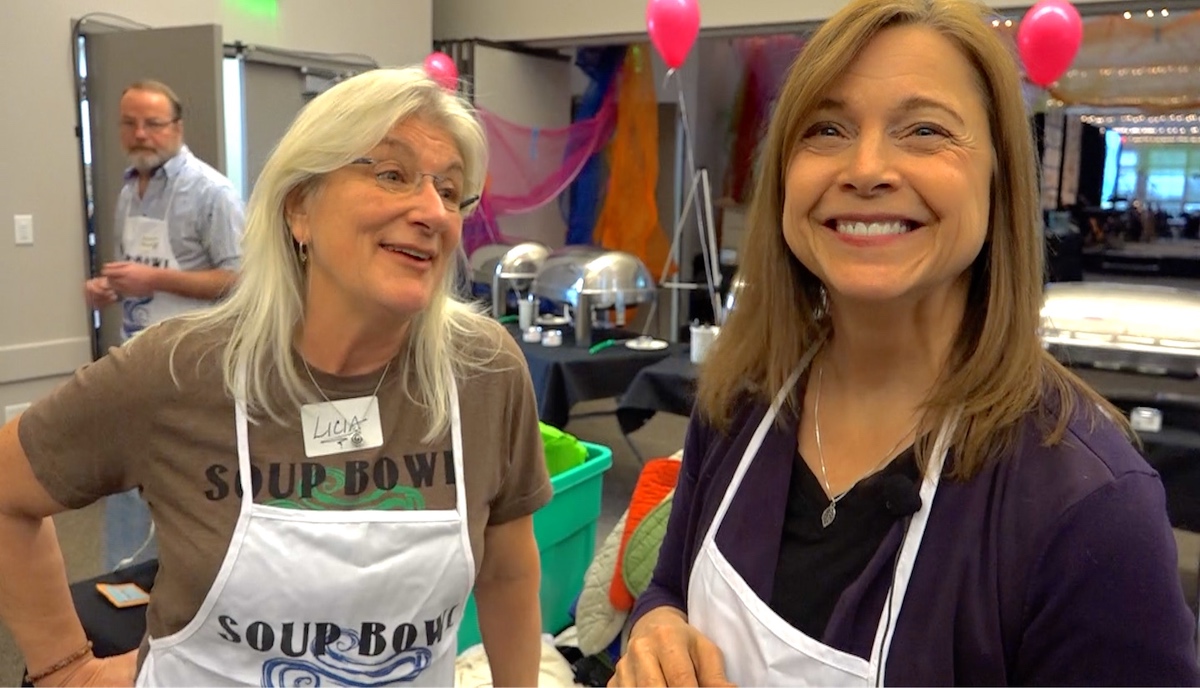
Soup Bowl volunteer Licia Weber (left) and Newcomer. Weber remembers “making a lot of soup” for the first Soup Bowl in 1994. | Photo by Duane Busick
“My dear friend Barb Bihler passed away in 2000,” Suzanne Halvorson said, “and every time I come to this, she is the person that I think of because she was so instrumental in the potters’ guild and getting this going. We were roommates in college, and my husband was her husband’s roommate in college. So whenever Jim brings his bowls, he always brings ten for himself and ten for Barb.”
Weber reminded Newcomer of the first Soup Bowl in 1994. “The first year, we made the soup, remember?” she said. “I remember making a lot of soup.”
“I remember that we ran out of spoons and we ran out of bowls because it was so successful, even the first year,” Newcomer said.
Potter Barb Lund participated the first year. “That first Soup Bowl in my memory — of course everybody’s memory is different — I think like a hundred and forty people came,” she said. “They had no idea how many people to expect. I brought bowls and then I went home. And then I got this frantic call from Suzanne Halvorson, which is one of the things I will never forget. Suzanne said, ‘Barb! Bring every bowl you have!’ And I did. I’ve always brought huge amounts of bowls ever since.” Lund took 200 bowls to each benefit for several years.

Soup Bowl co-founder Robert Meitus said 150 people attended the first Soup Bowl. | Photo by Duane Busick
Entertainment has been a part of the Soup Bowl since the first event in 1994. “That was in the basement of St. Paul’s Catholic Church,” Meitus said, “and I think there were three bands, as I recall. Carrie played along with Monkey Puzzle, and if I’m not mistaken it may have been the Bathtub Virgins. We had about a hundred and fifty people and it sold out that first year. We barely had enough bowls, and every year since, twenty-five years, it’s filled up with the support of this great community.”
“I think people were really captured by the idea of mixing arts and pottery and local restaurants,” Newcomer said, “and then all this going for the food bank. It just seemed to capture peoples’ imagination. So even the first year, we were pulling people out of line to help us wash spoons.”
Bass remembers the first benefit. “I was one those people in line that first year,” she said. “I was not one of the organizers, but within about an hour I’d been recruited into the kitchen to help clean bowls and wash spoons. So I’ve been involved since that very moment. That’s all you need: Get somebody to participate, and then they’re hooked.”
In the early years, Bass said, she and Newcomer would buy butter at Sam’s Club and scrounge for spoons at dollar stores. Newcomer said she and Bass were the soup squad, picking up soup from local restaurants in Newcomer’s van. The first restaurants included Lennie’s, Village Deli, Uptown Cafe, Laughing Planet, and Bloomingfoods. In recent years, about 40 Bloomington restaurants donated soup.
Hoosier Hills Food Bank Executive Director Julio Alonso detailed some of the work involved in getting the donations. “It takes about four to five contacts with every restaurant to get them to commit, get the ingredients, get a pickup time, get all that squared away,” he said. Then, the day before the Soup Bowl, the food bank staff picked up soup from the restaurants and delivered it to the convention center.
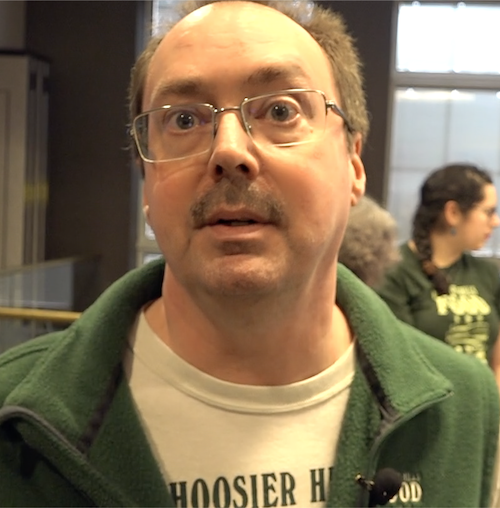
Hoosier Hills Food Bank Executive Director Julio Alonso said the Soup Bowl “exemplifies the best of Bloomington.” | Photo by Duane Busick
The soups were then organized and managed by Phil Phillipy, store manager at Bloomingfoods. He helped in the kitchen at the Soup Bowl for many years, but doesn’t know exactly how he got started. “I think someone just asked me to do it and didn’t know any better,” he said. “I was young, optimistic, and I just did it.” He said about 200 gallons of soup were prepped for the 25th Soup Bowl. “We’ve got 43 individual soups and about 88 to 90 pans of soup,” he said. “We’re just organizing the soup, bringing it up to temp before bringing it out to the floor. I think this an amazing event, I’m really proud to be a part of it every year. It does so much for our community and so many people pull together for this one day. It’s really an amazing thing.”
Phillipy’s wife, Selena Phillipy, checked the ingredients of each the soup so she could mark them as Vegan, Vegetarian, or Meat. “It’s kind of nice to be in the back of the house and just do the heating up,” Selena said. “But usually when we’re done, we go out, walk around, and chat with everybody. It’s just amazing. I think the money they bring in is outstanding. It keeps getting bigger and bigger each year.”
In 1996, Susan Snyder was teaching a class at the John Waldron Arts Center when she heard about the event. “I had just moved back to Bloomington after training in ceramics in Italy,” Snyder said, “so I started the first year I was back.” One year, Snyder took ten of her Italian maiolica bowls and also twenty bowls created by her Pottery House Studio students. “It’s so nice to see how potters and area restaurants and musicians and members of the community can all come together and create something so special and help out so much, all sharing in the spirit of contributing to this fantastic event.”
As Snyder inventoried the nearly 1,000 bowls donated by about fifty potters, another potter, Karen Green Stone, noticed several potters conversing around the myriad of colorful bowls displayed on the tables at the convention center. “They’re talking about clay bodies and glazes,” she said. “And the potters are actually looking at other people’s work and figuring out, ‘What did you do? How did you do that?’ ‘This worked, this didn’t work.’” She said potters use the Soup Bowl as an opportunity to experiment. “I know I do, with different ideas. And so, in terms of the potters, it’s great for us. It’s hard to believe we’ve grown up with this and it’s such a really important part of our lives. It’s just the right thing to do.”

Newcomer and Meitus (center) with soup bowl potters at the 2020 Soup Bowl, which raised $150,000 for Hoosier Hills Food Bank. The benefit has raised $1.5 million since 1994. This year’s Soup Bowl will include a musical performance on the streaming service Mandolin. | Photo by Duane Busick
Green Stone’s husband, Robb Stone, worked downstairs at the convention center, maneuvering a crowd of more than 200 people who were waiting for the event to begin. The line snaked through the corridor and two meeting rooms. Barb Qualls was the first person in line. She says she goes early every year to get first choice of the bowls, but more important, participating is “a way we can really make a difference for the community. And I love the idea that people are using their arts, the potters, and then the restaurants also, for a greater good, and I think that’s what Bloomington is all about.”
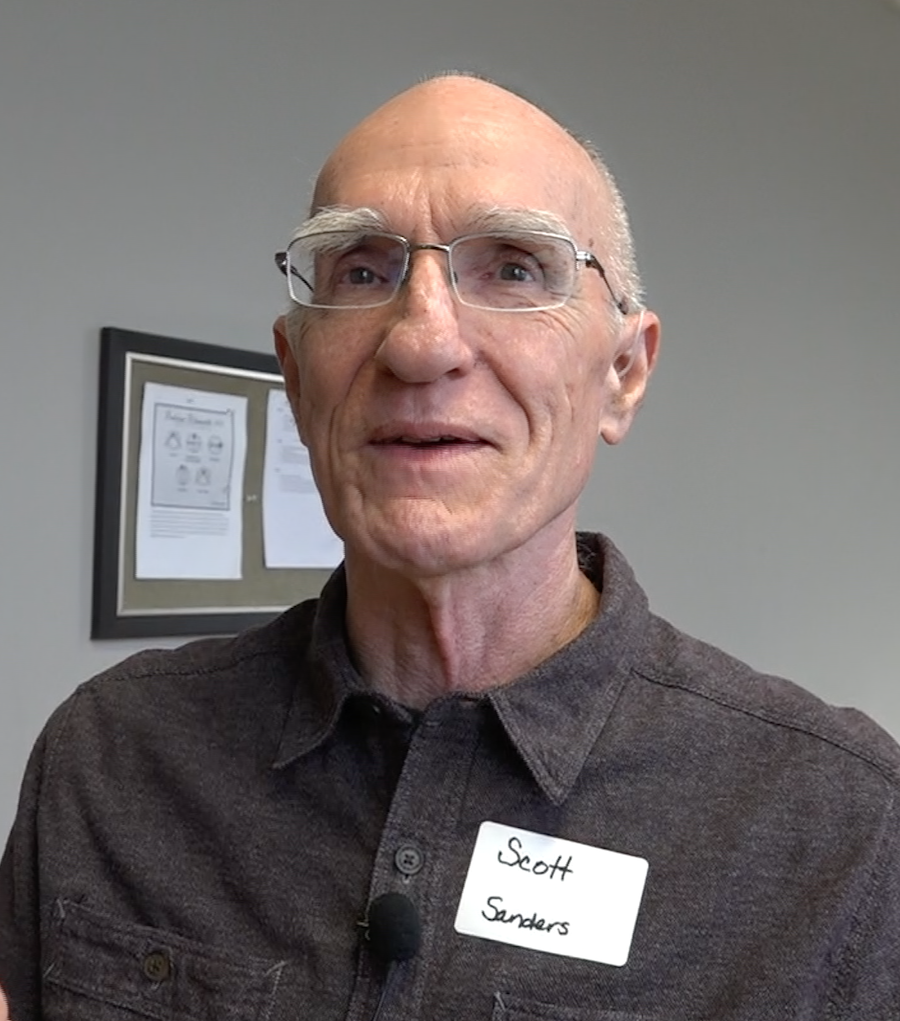
Bloomington author and Soup Bowl volunteer Scott Russell Sanders says the benefit “epitomizes what a community can do when they pool their resources and act out of generous motives to relieve suffering.” | Photo by Duane Busick
Susan Welsand and Terry Morgan were also near the front of the line. “I’ve been coming almost right from the beginning,” Welsand said. “I’ve been through all the changes of venue from the smaller spaces and now the convention center. I think it’s a great fundraiser. It shows the community spirit, the potters donating, the restaurants donating, and all the people coming out to support it.”
“We know a lot of the potters, too,” Morgan said. “So it’s always fun to get the bowls. We have a sideboard with stacks of Soup Bowl bowls.”
“There’s just something really lovely about the bowls being the center of it,” Newcomer said, “and the concept that we’re taking care of people in the community that need a little help right now.”
Scott Russell Sanders summed it up this way: “What Carrie and Robert did by bringing an idea here — [an idea] that caught on, and has now been sustained in this larger and larger event for twenty-five years — they demonstrate what good ideas can do. Ideas can be shared, and in being shared, it doesn’t deplete the idea. It doesn’t wear it out. It doesn’t take away from it. It enhances the significance of that. So there are now a whole series of Soup Bowls that are inspired by this one. Just as this one was inspired twenty-five years ago by an account. They didn’t witness it — they just heard a description of such an event. Ideas that are generous and that are shared, that don’t have patents on them or copyright around them, can enrich all of our lives.”
The 27th Soup Bowl Benefit
According to Julio Alonso, executive director or Hoosier Hills Food Bank, “In the nine months of COVID, we spent over $1.1 million on food purchasing, thanks to the generous help of local supporters and state and nation partners.” The food bank’s distribution total for 2020 in the region was more than 7 million pounds of food, a 39 percent increase over 2019, and the equivalent of more than 23,000 meals every day it was open.

Soup bowls made by local potters covering one of many tables at the 2019 Soup Bowl Benefit.
Tickets and sponsorships for the 27th Annual Soup Bowl Benefit for the Hoosier Hills Food Bank are available at hhfoodbank.org. Updates for the live music performance can be found on the Soup Bowl’s Facebook page.
TICKETS for a bowl and access to the livestream music show are $30. Organizers recommend ordering soup bowl tickets early because the supply of bowls is limited.
BOWLS can be picked up drive-thru style at the Monroe Convention Center parking lot on Friday, February 19, from 3 to 7 p.m., or Saturday, February 20, from 10 a.m. to 4 p.m. Bowls are handmade by local potters and will be randomly assigned. People are encouraged to buy soup from a local restaurant or download a PDF of Soup Bowl recipes here.
LIVE MUSIC and other performances will be streamed on Sunday, February 21, from 5:30 to 7:30 p.m., hosted on the new music platform Mandolin (which Robert Meitus co-founded). The program will feature music, messages, and more from Carrie Newcomer, Keb’ Mo’, Joshua Bell, IU Soul Revue, Busman’s Holiday, Malcolm Dalglish, Ross Gay, Sam Bartlett, and Eric Schedler.
SHOW ONLY tickets (bowl not included) can be purchased for $15 at hhfoodbank.org.


